Sunday Morning in Liscannor
There are few things nicer than to get out for a walk on a Sunday morning in brilliant sunshine before Liscannor fills up with church-goers. In fact, with very few people in view, I satisfied my curiosity about a strange-looking bush that had been clipped into the shape of E.T. Or so it seemed. At first I thought it was meant to represent a parishioner, wearing a hooded cloak, kneeling as if asking forgiveness? I later learned it is a simplified nativity scene with kneeling Mary and standing Joseph and the baby Jesus in a crib!
 I rounded the corner where the church sits on Main Street and approached the area of the village that will forever amuse me. Yesterday afternoon, I’d told our friends Bev and Steve (an American couple that built a house in Lahinch), that Mark Cronin, the new GM of the Cliffs of Moher Hotel, deemed this block-long beehive of activity in little Liscannor “The Strip”. I could see the wheels whirring in Steve’s head as images of Las Vegas enveloped his imagination, comparing it to this quaint collection of hotels, restaurants and pubs.
I rounded the corner where the church sits on Main Street and approached the area of the village that will forever amuse me. Yesterday afternoon, I’d told our friends Bev and Steve (an American couple that built a house in Lahinch), that Mark Cronin, the new GM of the Cliffs of Moher Hotel, deemed this block-long beehive of activity in little Liscannor “The Strip”. I could see the wheels whirring in Steve’s head as images of Las Vegas enveloped his imagination, comparing it to this quaint collection of hotels, restaurants and pubs.
Steve laughed and replied, “It does take some getting used to here in County Clare.”
 I kept to the church side of Main Street, anticipating the new bakery, located in what used to be Patrick Egan’s Books + Wine shop. That is where I first met Patrick, appearing to him as just one of thousands of American tourists passing through. This was back in 2010, my first full summer living in Ireland. And it is living in Ireland vs. visiting Ireland, which initially inspired me to start writing short stories. I wanted to focus my attention on what made Ireland different and special, having immediately recognized there was an ample number of sights and sounds that were wondrous. I strived to capture them, forcing myself to be more observant, since it is so easy to take all this beauty, and even the quirkiness, for granted.
I kept to the church side of Main Street, anticipating the new bakery, located in what used to be Patrick Egan’s Books + Wine shop. That is where I first met Patrick, appearing to him as just one of thousands of American tourists passing through. This was back in 2010, my first full summer living in Ireland. And it is living in Ireland vs. visiting Ireland, which initially inspired me to start writing short stories. I wanted to focus my attention on what made Ireland different and special, having immediately recognized there was an ample number of sights and sounds that were wondrous. I strived to capture them, forcing myself to be more observant, since it is so easy to take all this beauty, and even the quirkiness, for granted.
The Sea Salt artisan bakery is a very enticing place indeed. At 10 AM it was doing a brisk business, with a line starting to form out the door. You only have to poke your head in to see why. I did that very thing a couple of days ago in my initial reconnaissance to survey what was going on in our little fishing village.
 The sunshine and near-balmy air brings out the surfers, golfers, dog-walkers, beach-goers, and mothers pushing their babies in prams, along with people like me just strolling along, admiring the profusion of myriad flowering shrubs with their riotous display of yellow, pink and lavender blossoms.
The sunshine and near-balmy air brings out the surfers, golfers, dog-walkers, beach-goers, and mothers pushing their babies in prams, along with people like me just strolling along, admiring the profusion of myriad flowering shrubs with their riotous display of yellow, pink and lavender blossoms.
When I reached the end of the block, I crossed over Main Street and noticed a couple of older gents sitting on benches outside the Anchor Inn. I figured I must look ridiculous to them, since there was just enough chill in the air for me to be wearing my lavender zip-up jacket. No matter that it was ultra-lightweight and is the perfect windbreaker for this kind of breezy weather. They’d be thinking the same thing this burly grizzled guy said to me during my first recon a couple of days ago, when I ambled into McHugh’s Pub…
He deadpanned, “Where’s your earmuffs and mittens?”
I took the bait. “I live in Arizona, so this feels a little chilly to me.”
Along with looking like an alien, it’s as if I was speaking Swahili. I teased him along with, “Have you ever heard of the Grand Canyon?”
This was met with a tepid nod of the head and a swig of his drink.
“Well, I live in the desert—in the same state as the Grand Canyon—and it is often quite warm there.”
“You mean hot like it is here? Jaysus, it’s roasting!” yer man on the barstool declared.
“Are you kidding me? This isn’t hot. This is only about 72 degrees. That would be about 21 celsius,” I said with a cheerful smile, engaging in a bit of barroom banter.
“Could you convert that for me?”
Was the public house patron pulling my leg?
“I just did. Twenty-one celsius is actually 71 Fahrenheit. That’s how I remember it,” I replied rather matter-of-factly, rebutting what I hoped was his tongue-in-cheek question.
He lifted an eyebrow. “What are you? A schoolteacher?”
We were both laughing when I said, while shaking my finger at him, “No, I’m not, but I should have been!”
Figuring that was a good time to wrap up our short repartee, I said goodbye and was on my way.
J.P. Holland Centre
Back to today’s walkabout. I wanted to see if the new J.P. Holland Centre was open on the corner close to what used to be called The Tides shop. I noticed some refurbishment going on there last summer and figured The Tides should be open for business by now. Maybe not this early on a Sunday morning, but at least open to take advantage of this being the high season in County Clare.
The Tides was still completely closed; but to my surprise and delight, the front door of J. P. Holland Centre was propped wide open. Before I entered, I noticed a small plaque affixed to a waist-high tree stump:
Fulacht Fiadh
Bronze Age circa 2500 BC
Just beyond it in the courtyard was an odd collection of stone slabs, creating a squarish tub. The plaque told the story of how water was poured into the tub, then brought to a boil. Meat was cooked in the water, which was thought to have remained hot for as much as three hours. Alternative uses for the Fulacht Fiadh could have been bathing, dyeing, or even brewing! Not all at once, mind you.
 Once through the outer doors I was in a tiny vestibule. I was amazed to see some yellowed newspaper clippings about the “Submarine Boat Inventor” during the days when Holland was a resident of Patterson, New Jersey. On the opposing wall of the entry hall was a framed reprint of John P. Holland’s Six Submarines, 1878 – 1900, listing their various names, where they were built, and where they were launched.
Once through the outer doors I was in a tiny vestibule. I was amazed to see some yellowed newspaper clippings about the “Submarine Boat Inventor” during the days when Holland was a resident of Patterson, New Jersey. On the opposing wall of the entry hall was a framed reprint of John P. Holland’s Six Submarines, 1878 – 1900, listing their various names, where they were built, and where they were launched.
Along with Holland No. 1, the Fenian Ram, and the Zalinski Boat, another was named Plunger. It was launched 7 August 1897. Place: Baltimore, MD. The builder was William Malster’s Columbian Iron Works. Plunger weighed 168 tons and was armed with: Two Torpedo Tubes; Five Torpedoes.
Two more steps and I found myself in a spacious gift shop. Along with postcards, an array of scarfs, sweaters, and knick knacks, there was a counter along one wall with a coffee machine and a few chairs.
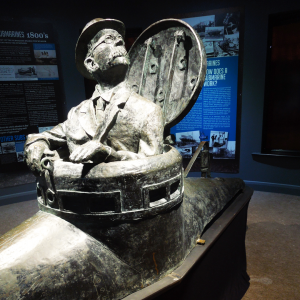 Display cases arranged in a big square in the middle of the room provided both shelving for souvenirs and the pay point for a cashier/shop minder. To the young lady behind the counter, I declared, “I had no idea that J.P. Holland designed six submarines!”
Display cases arranged in a big square in the middle of the room provided both shelving for souvenirs and the pay point for a cashier/shop minder. To the young lady behind the counter, I declared, “I had no idea that J.P. Holland designed six submarines!”
“Not many people know that,” she replied with a charming smile.
A stack of books sat prominently on the counter to her left, looking very much to be the definitive story of the self-trained inventor-engineer, J.P.Holland (1841 – 1914). The cover of one featured the often-reproduced photo of the mustachioed man, emerging from his submarine, wearing wire rim spectacles and black bowler hat.
“I didn’t bring any money with me, so I’ll have to come back for this book,” I said to the pretty lass, whose thick blonde hair was pulled back into a ponytail.
I wandered over to the entrance of the museum and could see that the big bronze sculpture of Holland that used to be positioned in front of what is now the Cliffs of Moher Hotel, looked like it had finally found a permanent home.
I came back to the counter to note the author of the book. His name was Richard Knowles Morris.
“Were you here a couple of years ago when there was a dedication ceremony for Holland down by the harbor? It was the 100th anniversary of his death,” I asked, curious how familiar she’d be with Holland.
“No, I wasn’t there that day,” she said, rather amazed that I knew about this momentous event.
 “It was a really big deal. A huge ship from the Irish Naval fleet anchored in the bay and the captain came ashore for the ceremony. And the captain was a woman!” I blurted out with admiration for this exalted lady officer. “She was so impressive in her dark blue uniform. She had on a skirt and was wearing some very smart looking shoes with a block high heel.”
“It was a really big deal. A huge ship from the Irish Naval fleet anchored in the bay and the captain came ashore for the ceremony. And the captain was a woman!” I blurted out with admiration for this exalted lady officer. “She was so impressive in her dark blue uniform. She had on a skirt and was wearing some very smart looking shoes with a block high heel.”
My pony-tailed audience seemed enraptured, so I went on.
“There was also a highly-decorated American Naval officer,” I said, unable to remember his exact rank, but I did recall there was a chest-full of ribbons, badges and medals on his starched dress blue uniform. I don’t know what it is about men in uniform, but there is some kind of mystique. Do men think the same thing about women in uniform? Somehow, I rather doubt it.
 “And there was even a guy from the Japanese Cultural Office in Dublin,” I offered. “He said he had come to represent Japan, since the Ambassador was unable to attend himself.”
“And there was even a guy from the Japanese Cultural Office in Dublin,” I offered. “He said he had come to represent Japan, since the Ambassador was unable to attend himself.”
With this, the cute freckle-faced young lady was able to help me out. “Oh yeah, I remember reading that the Japanese used his design too.”
Then I ventured, “I wonder if the author of this book is the same guy who gave a speech about Holland during the ceremony? He seemed to be quite an authority.”
Her blue eyes lit up. “That was probably Tony Duggan. He was here a lot helping to put the museum together. He’s from Cork.”
I appreciated her genuine friendliness. “Where are you from? Clare?”
“Miltown Malbay. Not too far away,” she replied, flashing her pearly white smile again.
I was thoroughly enjoying her effervescent sweetness. “What is your name?”
“Grace.”
“Oh my,” I gasped. “A couple nights ago, I was watching a webcast, and a lady was talking about a book she had written called The Grace Trail. Have you ever heard of it?”
“No,” she said with a shake of her ponytail.
“It was all about finding a state of grace, especially when you have lost your footing—your emotionally footing—like if your child died, or something tragic like that.” I tried to further explain as best I could, having been pretty jet-lagged at the time, and fighting mightily to stay up until midnight to watch this program, airing at 7 PM eastern time in the U.S. “The author talked about The Grace Trail being something she created after she learned about war veterans, probably Vietnam Veterans, who were walking the Appalachian Trail. Have you heard of it?”
“Oh yes,” darling Grace said emphatically.
“It goes something like 2,000 miles I think—all the way from Maine to Tennessee maybe,” I fumbled, vaguely remembering it included the Smoky Mountains. At that moment, I realized I didn’t know much about it, other than what I read in Bill Bryson’s hilarious book, A Walk in the Woods. It was so laugh-out-loud funny, I can see why somebody would want to make a movie out of it, but even with Robert Redford playing the lead role, it fell completely flat and I couldn’t finish watching it!
“Some people set out to walk the entire trail over—I don’t know—over how many months. Other people hike it a chunk at a time. But the author, Anne Jolles is her name, said the vets were ‘walking off the war.’”
 I was proud that I could recall this much, given I was barely able to keep awake. “So anyway, the author created her own Grace Trail, where people could walk, and at regular intervals there’d be a little message on a post, to help them contemplate and heal. She said GRACE was also an acronym for the five steps to finding your way back to firmer footing. G for gratitude. R for release. A… could have been for acceptance?” I struggled to remember.
I was proud that I could recall this much, given I was barely able to keep awake. “So anyway, the author created her own Grace Trail, where people could walk, and at regular intervals there’d be a little message on a post, to help them contemplate and heal. She said GRACE was also an acronym for the five steps to finding your way back to firmer footing. G for gratitude. R for release. A… could have been for acceptance?” I struggled to remember.
Grace chimed in, “Maybe C was for clarity?”
That gave me goose bumps, because I think she surmised correctly. And if that wasn’t right, it was so perceptive.
“That’s awesome, Grace. That may be exactly what C was for. And E, I think, was embrace. Embrace where you are. Embrace who you are.”
Our intimate moment evaporated when another lady came in and headed straight over to the coffee machine. Apparently getting it to produce a cup of coffee posed a bit of a struggle, and Grace had to come around the counter and help her sort it out.
I said goodbye as I headed for the door, hoping to come back soon with money in my pocket. I was planning to buy the book and learn once and for all if J.P. Holland was born in Liscannor, as most people, including Grace, are inclined to believe.
 On my way home, I decided to take another look at Holland’s Cottage, identified by the stone sign affixed to the left of the green front door, with the funny looking torpedo-shaped Fenian Ram also etched into the stone.
On my way home, I decided to take another look at Holland’s Cottage, identified by the stone sign affixed to the left of the green front door, with the funny looking torpedo-shaped Fenian Ram also etched into the stone.
To the right of the door was a rose bush that obviously has been lovingly pruned for many years, and was climbing nearly to the slate roof. It bore the most luxurious salmony-pink flowers, each perfect petal a delicate declaration that summer is here.
Right here on this door step.
Whether or not this is Holland’s actual birthplace, or he ever lived in this house, there are roses galore to greet whoever is lucky enough to grace this doorway now.
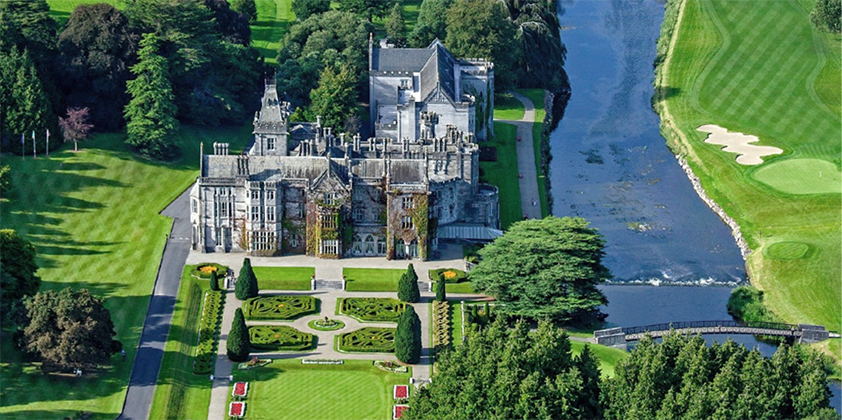
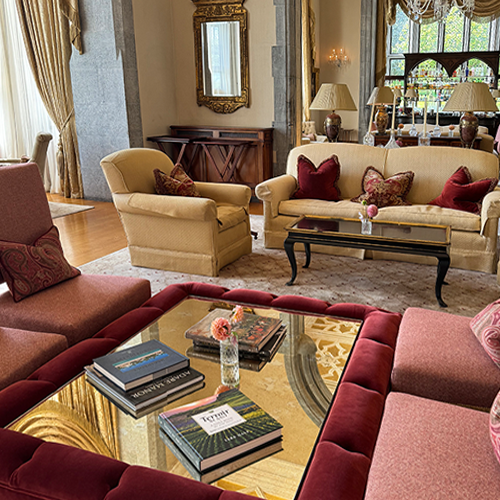 It was wonderful to see Terroir on table at Adare in drawing room
It was wonderful to see Terroir on table at Adare in drawing room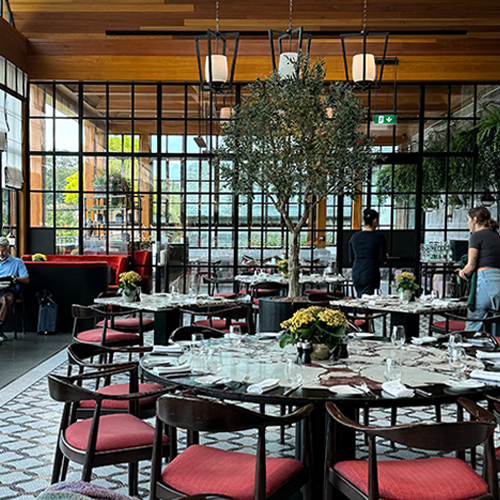 Adare Manor Carriage House Restaurant
Adare Manor Carriage House Restaurant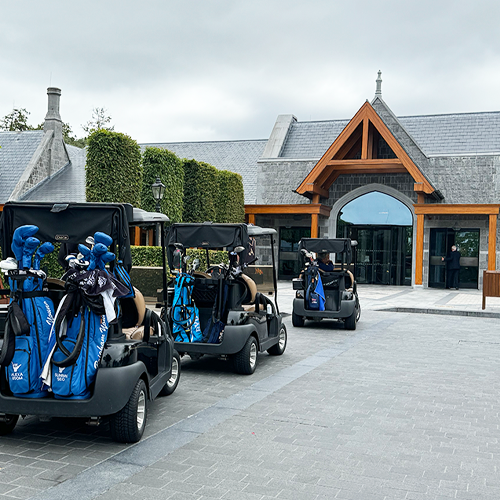 Everything is highly professional and efficient at Adare Manor Resort
Everything is highly professional and efficient at Adare Manor Resort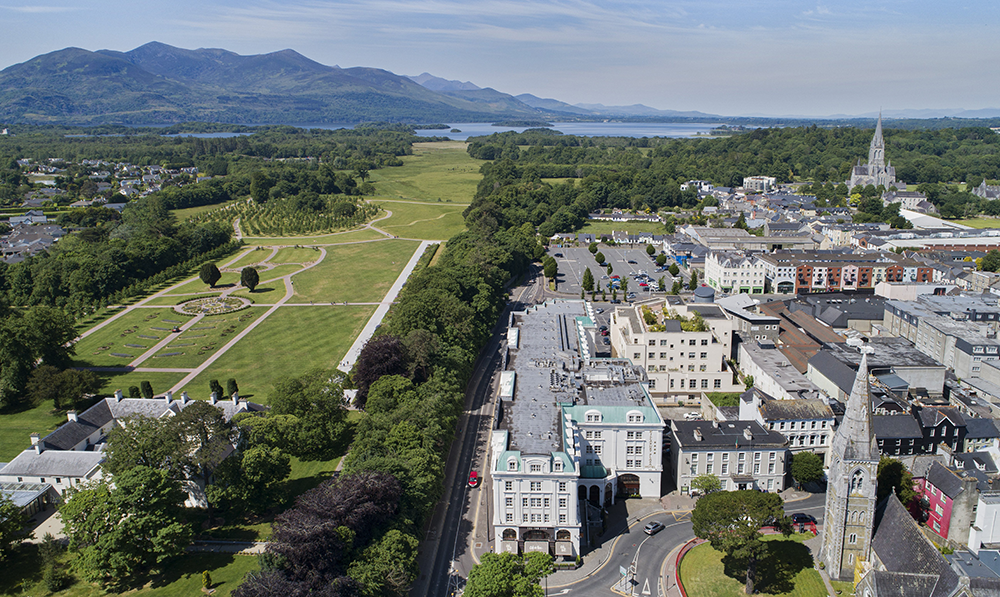
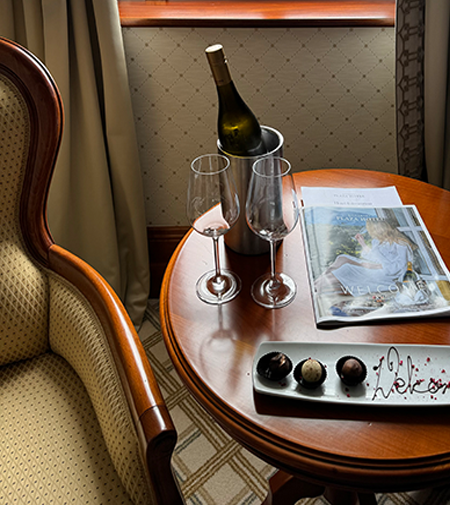 Welcome treats greeting us in our suite
Welcome treats greeting us in our suite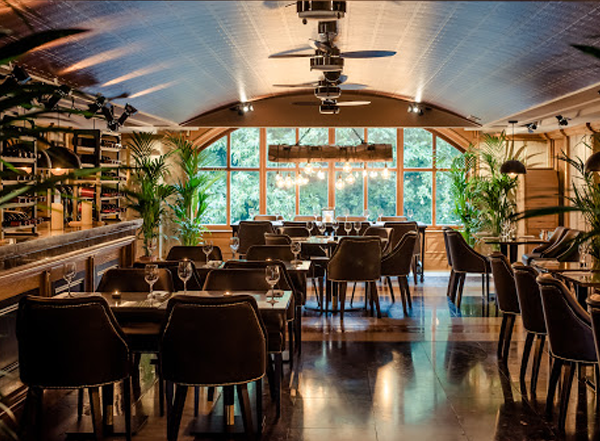 The Tan Yard offers flavoursome ‘farm to fork’ experience
The Tan Yard offers flavoursome ‘farm to fork’ experience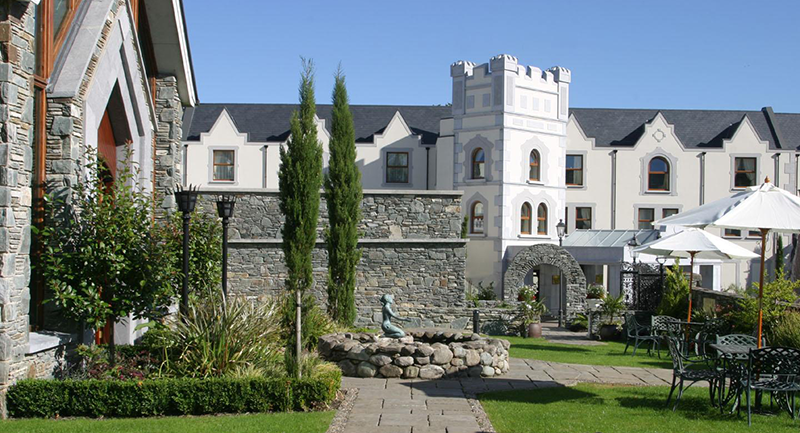
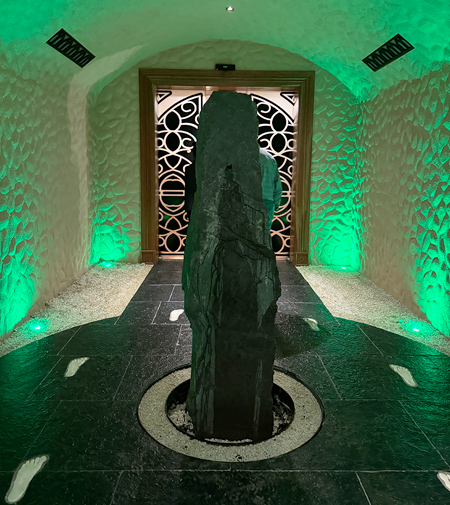 The light color changing entrance to the Spa is an absolute show-stopper
The light color changing entrance to the Spa is an absolute show-stopper 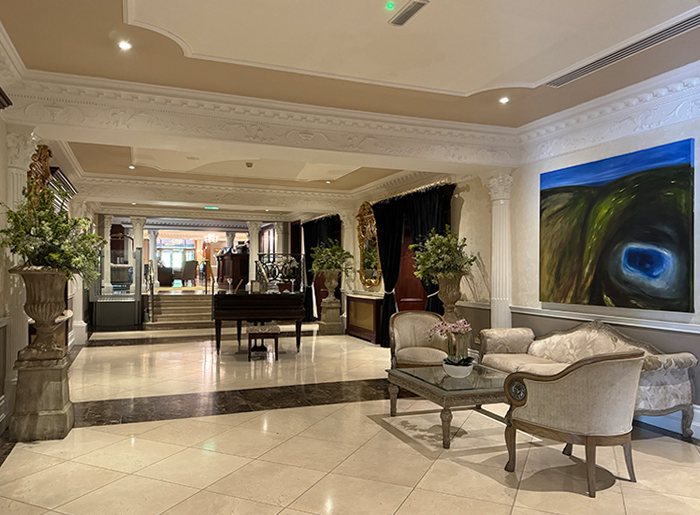 The elegant lobby of the Muckross Park Hotel
The elegant lobby of the Muckross Park Hotel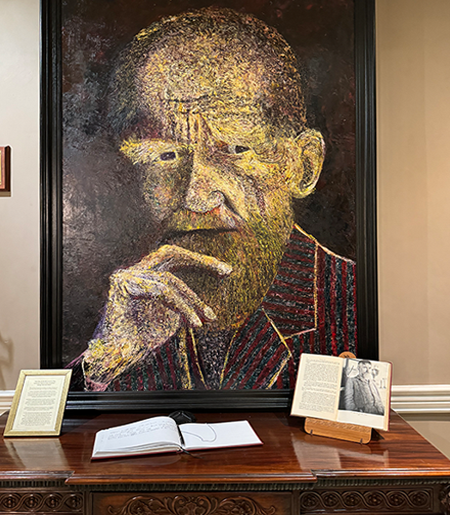 Portrait of George Bernard Shaw, by Irish artist Mark McFadden
Portrait of George Bernard Shaw, by Irish artist Mark McFadden 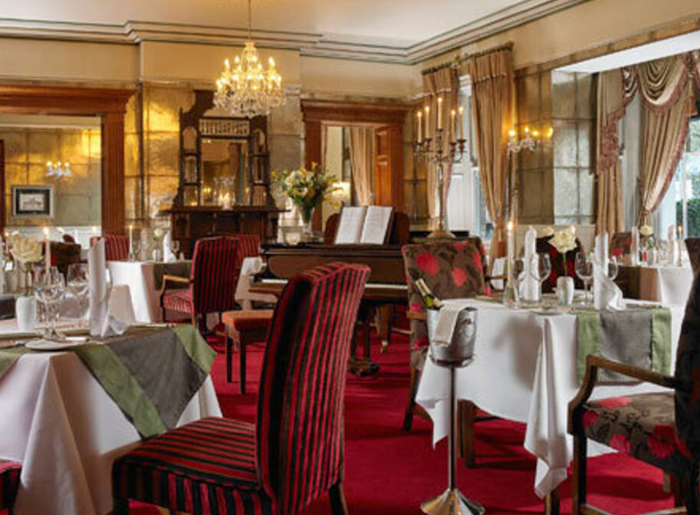 The Yew Tree Restaurant is set in the original Victorian lounge of the hotel, and counts 2 AA Rosettes among its awards.
The Yew Tree Restaurant is set in the original Victorian lounge of the hotel, and counts 2 AA Rosettes among its awards. 















 A second nine was added two years later with the involvement of another Scot, George Coburn, who hailed from East Lothian. A skillful player, Coburn, at just nineteen years of age, was engaged to replace Mungo Park as the Club professional. He had gained valuable greenkeeping experience with Old Tom Morris, and is even thought to have assisted Old Tom with the New Course at St Andrews when he designed it in 1895.
A second nine was added two years later with the involvement of another Scot, George Coburn, who hailed from East Lothian. A skillful player, Coburn, at just nineteen years of age, was engaged to replace Mungo Park as the Club professional. He had gained valuable greenkeeping experience with Old Tom Morris, and is even thought to have assisted Old Tom with the New Course at St Andrews when he designed it in 1895.


 When we drifted into the member’s inner sanctum of the Pickeman Room, John Power, the Captain, pointed to the only open window and said, “You know Gary Player, the famous golfer?”
When we drifted into the member’s inner sanctum of the Pickeman Room, John Power, the Captain, pointed to the only open window and said, “You know Gary Player, the famous golfer?”
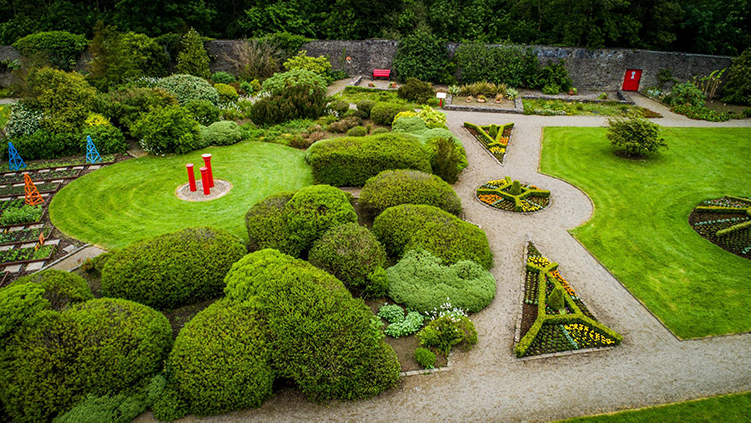
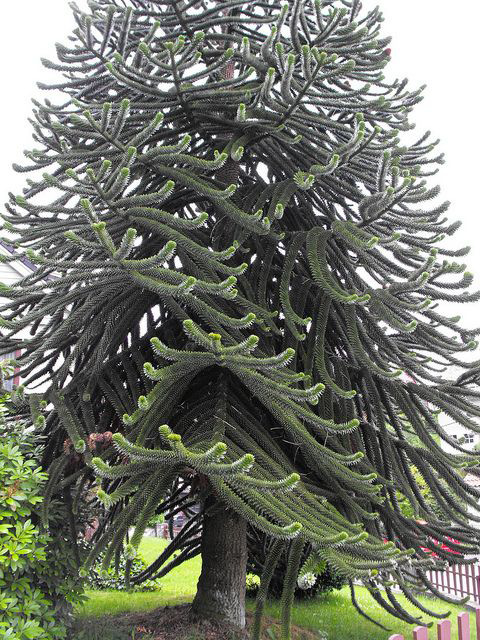 Before we left the house I searched online to make sure Vandeleur was open. I also read it had an exceptional collection of trees from oak and mountain ash to the quirky monkey puzzle tree.
Before we left the house I searched online to make sure Vandeleur was open. I also read it had an exceptional collection of trees from oak and mountain ash to the quirky monkey puzzle tree.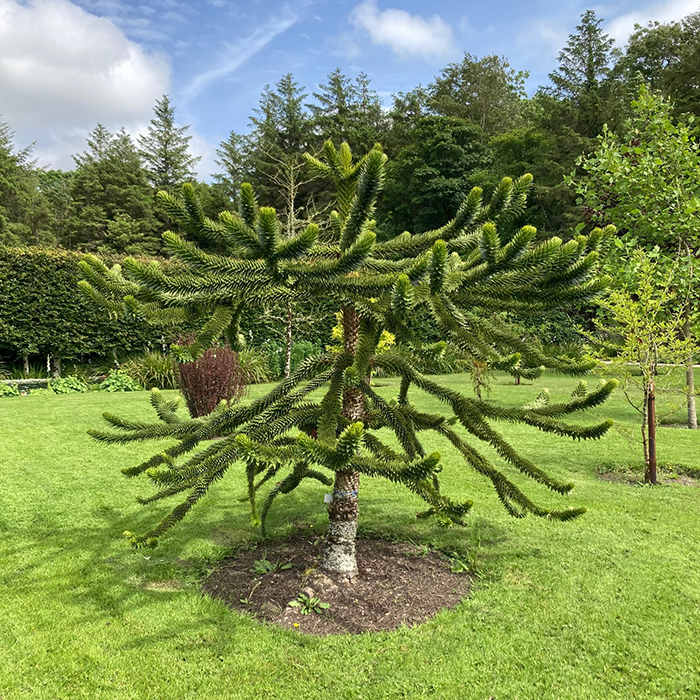 “Sorry to bother you but could you tell me where is the monkey puzzle tree?”
“Sorry to bother you but could you tell me where is the monkey puzzle tree?”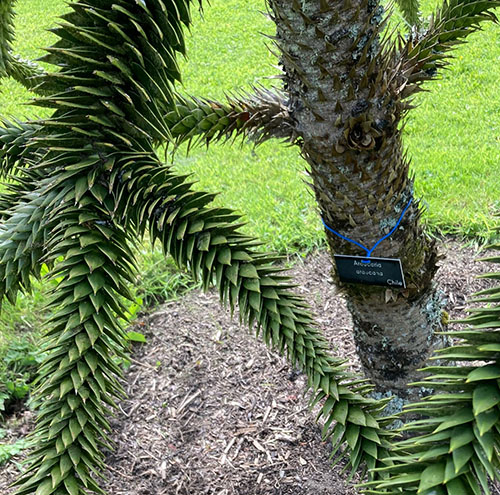 “How long would it take to get this tall?” I asked.
“How long would it take to get this tall?” I asked.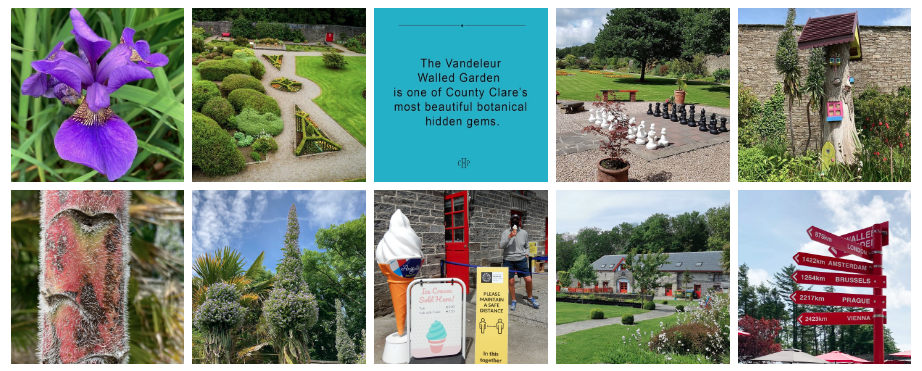

 I rounded the corner where the church sits on Main Street and approached the area of the village that will forever amuse me. Yesterday afternoon, I’d told our friends Bev and Steve (an American couple that built a house in Lahinch), that Mark Cronin, the new GM of the Cliffs of Moher Hotel, deemed this block-long beehive of activity in little Liscannor “The Strip”. I could see the wheels whirring in Steve’s head as images of Las Vegas enveloped his imagination, comparing it to this quaint collection of hotels, restaurants and pubs.
I rounded the corner where the church sits on Main Street and approached the area of the village that will forever amuse me. Yesterday afternoon, I’d told our friends Bev and Steve (an American couple that built a house in Lahinch), that Mark Cronin, the new GM of the Cliffs of Moher Hotel, deemed this block-long beehive of activity in little Liscannor “The Strip”. I could see the wheels whirring in Steve’s head as images of Las Vegas enveloped his imagination, comparing it to this quaint collection of hotels, restaurants and pubs. I kept to the church side of Main Street, anticipating the new bakery, located in what used to be Patrick Egan’s Books + Wine shop. That is where I first met Patrick, appearing to him as just one of thousands of American tourists passing through. This was back in 2010, my first full summer living in Ireland. And it is living in Ireland vs. visiting Ireland, which initially inspired me to start writing short stories. I wanted to focus my attention on what made Ireland different and special, having immediately recognized there was an ample number of sights and sounds that were wondrous. I strived to capture them, forcing myself to be more observant, since it is so easy to take all this beauty, and even the quirkiness, for granted.
I kept to the church side of Main Street, anticipating the new bakery, located in what used to be Patrick Egan’s Books + Wine shop. That is where I first met Patrick, appearing to him as just one of thousands of American tourists passing through. This was back in 2010, my first full summer living in Ireland. And it is living in Ireland vs. visiting Ireland, which initially inspired me to start writing short stories. I wanted to focus my attention on what made Ireland different and special, having immediately recognized there was an ample number of sights and sounds that were wondrous. I strived to capture them, forcing myself to be more observant, since it is so easy to take all this beauty, and even the quirkiness, for granted. The sunshine and near-balmy air brings out the surfers, golfers, dog-walkers, beach-goers, and mothers pushing their babies in prams, along with people like me just strolling along, admiring the profusion of myriad flowering shrubs with their riotous display of yellow, pink and lavender blossoms.
The sunshine and near-balmy air brings out the surfers, golfers, dog-walkers, beach-goers, and mothers pushing their babies in prams, along with people like me just strolling along, admiring the profusion of myriad flowering shrubs with their riotous display of yellow, pink and lavender blossoms. Once through the outer doors I was in a tiny vestibule. I was amazed to see some yellowed newspaper clippings about the “Submarine Boat Inventor” during the days when Holland was a resident of Patterson, New Jersey. On the opposing wall of the entry hall was a framed reprint of John P. Holland’s Six Submarines, 1878 – 1900, listing their various names, where they were built, and where they were launched.
Once through the outer doors I was in a tiny vestibule. I was amazed to see some yellowed newspaper clippings about the “Submarine Boat Inventor” during the days when Holland was a resident of Patterson, New Jersey. On the opposing wall of the entry hall was a framed reprint of John P. Holland’s Six Submarines, 1878 – 1900, listing their various names, where they were built, and where they were launched. Display cases arranged in a big square in the middle of the room provided both shelving for souvenirs and the pay point for a cashier/shop minder. To the young lady behind the counter, I declared, “I had no idea that J.P. Holland designed six submarines!”
Display cases arranged in a big square in the middle of the room provided both shelving for souvenirs and the pay point for a cashier/shop minder. To the young lady behind the counter, I declared, “I had no idea that J.P. Holland designed six submarines!” “It was a really big deal. A huge ship from the Irish Naval fleet anchored in the bay and the captain came ashore for the ceremony. And the captain was a woman!” I blurted out with admiration for this exalted lady officer. “She was so impressive in her dark blue uniform. She had on a skirt and was wearing some very smart looking shoes with a block high heel.”
“It was a really big deal. A huge ship from the Irish Naval fleet anchored in the bay and the captain came ashore for the ceremony. And the captain was a woman!” I blurted out with admiration for this exalted lady officer. “She was so impressive in her dark blue uniform. She had on a skirt and was wearing some very smart looking shoes with a block high heel.” “And there was even a guy from the Japanese Cultural Office in Dublin,” I offered. “He said he had come to represent Japan, since the Ambassador was unable to attend himself.”
“And there was even a guy from the Japanese Cultural Office in Dublin,” I offered. “He said he had come to represent Japan, since the Ambassador was unable to attend himself.” I was proud that I could recall this much, given I was barely able to keep awake. “So anyway, the author created her own Grace Trail, where people could walk, and at regular intervals there’d be a little message on a post, to help them contemplate and heal. She said GRACE was also an acronym for the five steps to finding your way back to firmer footing. G for gratitude. R for release. A… could have been for acceptance?” I struggled to remember.
I was proud that I could recall this much, given I was barely able to keep awake. “So anyway, the author created her own Grace Trail, where people could walk, and at regular intervals there’d be a little message on a post, to help them contemplate and heal. She said GRACE was also an acronym for the five steps to finding your way back to firmer footing. G for gratitude. R for release. A… could have been for acceptance?” I struggled to remember. On my way home, I decided to take another look at Holland’s Cottage, identified by the stone sign affixed to the left of the green front door, with the funny looking torpedo-shaped Fenian Ram also etched into the stone.
On my way home, I decided to take another look at Holland’s Cottage, identified by the stone sign affixed to the left of the green front door, with the funny looking torpedo-shaped Fenian Ram also etched into the stone.
